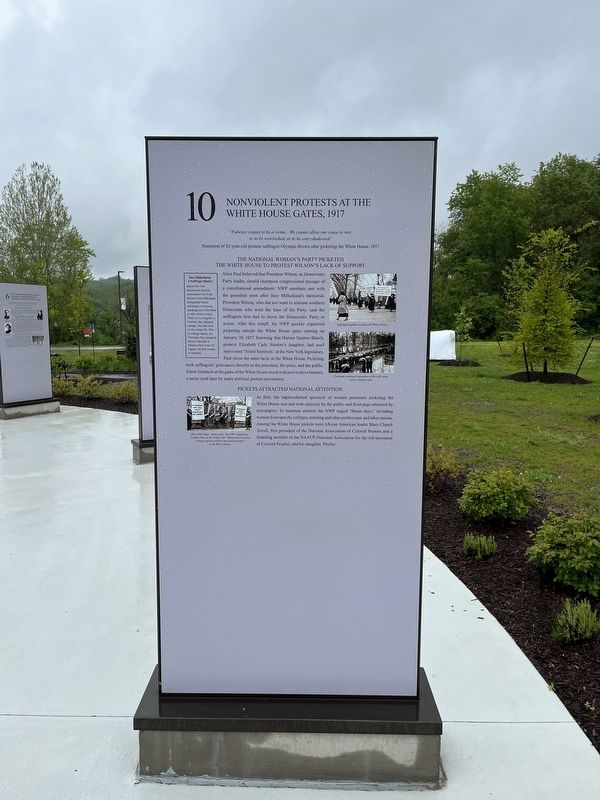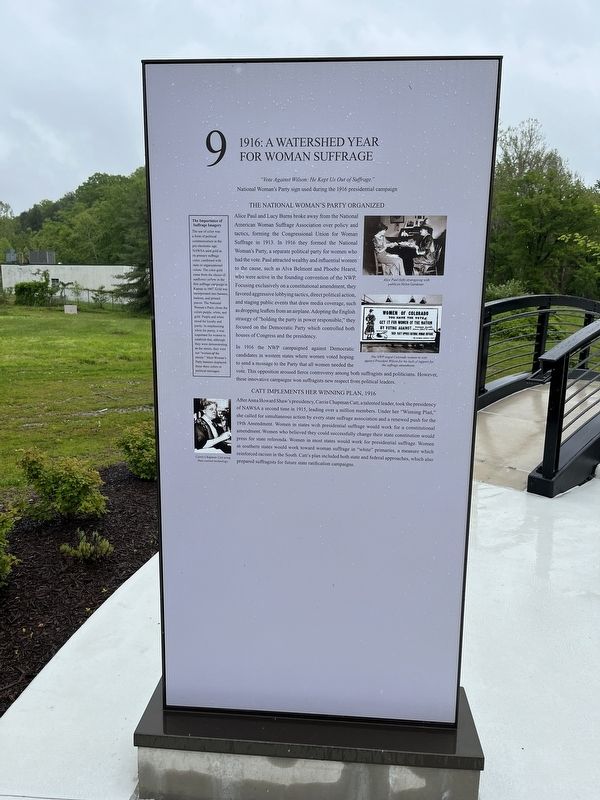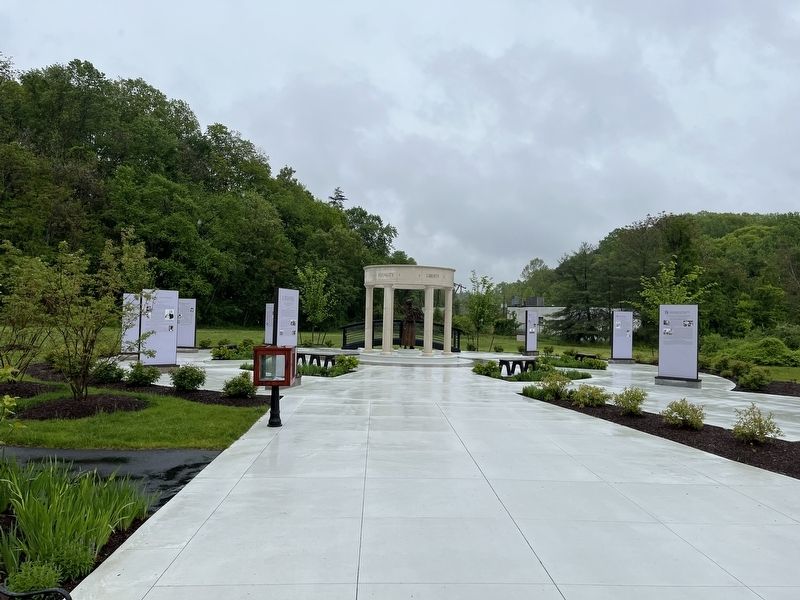Lorton in Fairfax County, Virginia — The American South (Mid-Atlantic)
1916 / Nonviolent Protests at the White House Gates
1916: A Watershed Year for Woman Suffrage
"Vote Against Wilson: He Kept Us Out of Suffrage."
National Woman's Party sign used during the 1916 presidential campaign
The National Woman's Party Organized
Alice Paul and Lucy Burns broke away from the National American Woman Suffrage Association over policy and tactics, forming the Congressional Union for Woman Suffrage in 1913. In 1916 they formed the National Woman's Party, a separate political party for women who had the vote. Paul attracted wealthy and influential women to the cause, such as Alva Belmont and Phoebe Hearst, who were active in the founding convention of the NWP. Focusing exclusively on a constitutional amendment, they favored aggressive lobbying tactics, direct political action, and staging public events that drew media coverage, such as dropping leaflets from an airplane. Adopting the English strategy of "holding the party in power responsible," they focused on the Democratic Party which controlled both houses of Congress and the presidency.
In 1916 the NWP campaigned against Democratic candidates in western states where women voted hoping to send a message to the Party that all women needed the vote. This opposition aroused fierce controversy among both suffragists and politicians. However, these innovative campaigns won suffragists new respect from political leaders.
Catt Implements Her Winning Plan, 1916
After Anna Howard Shaw's presidency, Carrie Chapman Catt, a talented leader, took the presidency of NAWSA's a second time in 1915, leading over a million members. Under her "Winning Plan," she called for simultaneous action by every state suffrage association and a renewed push for the 19th Amendment. Women in states with presidential suffrage would work for a constitutional amendment. Women who believed they could successfully change their state constitution would press for state referenda. Women in most states would work for presidential suffrage. Women in southern states would work toward woman suffrage in "white" primaries, a measure which reinforced racism in the South. Catt's plan included both state and federal approaches, which also prepared suffragists for future state ratification campaigns.
[Sidebar:]
The Importance of Suffrage Imagery
The use of color was a form of political communication in the pre-election age. NAWSA used gold as its primary suffrage color, combined with state or organizational colors The color gold came from the choice of sunflower yellow in the first suffrage campaign in Kansas in 1867. Gold was incorporated into banners, buttons, and printed pieces. The National

Photographed By Devry Becker Jones (CC0), May 6, 2022
2. Nonviolent Protests at the White House Gates side of the marker
[Captions:]
Alice Paul (left) strategizing with publicist Helen Gardener.
The NWP urged Colorado to vote against President Wilson for his lack of support for the suffrage movement.
Carrie Chapman Catt using then-current technology.
Nonviolent Protests at the White House Gates, 1917
"Patience ceases to be a virtue… We cannot allow our cause to rest, or to be overlooked, or to be over-shadowed."
Statement of 82-year-old pioneer suffragist Olympia Brown after picketing the White House, 1917
The National Woman's Party Picketed the White House to Protest Wilson's Lack of Support
Alice Paul believed that President Wilson, as Democratic Party leader, should champion congressional passage of a constitutional amendment. NWP members met with the president soon after Inez Milholland's memorial. President Wilson, who did not want to alienate southern Democrats who were the base of his
Pickets Attracted National Attention
At first, the unprecedented spectacle of women protesters picketing the White House was met with curiosity and front page attention by newspapers. To maintain interest, the NWP staged "theme days," including women from specific colleges, teaching and other professions, and labor unions. Among the White House pickets were African American leader Mary Church Terrell, first president of the National Association of Colored Women and a founding member of the NAACP (National Association for the Advancement of Colored people), and her daughter Phyllis.
[Sidebar:]
Inez, Milholland, A Suffrage Martyr
Before the 1916 presidential election charismatic New York attorney Inez Milholland disregarded illness and began a strenuous speaking tour of the West to rally women voters. While in Los Angeles in October, she collapsed onstage. She later died on November 25, 1916. A suffrage martyr, her Christmas Day memorial service was held in Statuary Hall in the US Capitol, the first woman so honored.
[Captions:]
Suffragists gather to picket the White House.
Picketing continued regardless of the cold, sleet, rain or intense heat.
One of the many "theme days" the NWP staged was "College Day on the Picket Line." Women from various colleges served as Silent Sentinel protesters at the White House.
Erected 2021 by Turning Point Suffragist Memorial Association. (Marker Number 9/10.)
Topics and series. This historical marker is listed in these topic lists: African Americans • Air & Space • Civil Rights • Government & Politics • Women. In addition, it is included in the Elizabeth Cady Stanton, the Former U.S. Presidents: #28 Woodrow Wilson, and the Mary Church Terrell series lists. A significant historical year for this entry is 1916.
Location. 38° 40.939′ N, 77° 15.172′ W. Marker is in Lorton, Virginia, in Fairfax County. Marker is on Lorton Road, one mile south of Ox Road (Virginia Route 123), on the left when traveling east. Touch for map. Marker is at or near this postal address: 9751 Ox Rd, Lorton VA 22079, United States of America. Touch for directions.
Other nearby markers. At least 8 other markers are within walking distance of this marker. New Life in State by State Campaigns / The 1913 Suffrage Parade Captured National Attention (here, next to this marker); Suffrage Campaigns State By State / New Leaders, New Approaches (a few steps from this marker); The Suffrage Campaign in Wartime / Suffrage Pickets Chose Prison (a few steps from this marker); Building a Political Movement / Testing Constitutional Amendments (a few steps from this marker); Worsening Conditions / Violent Repression (a few steps from this marker); "Forward Out of Darkness" / Issuing a Call for Women's Rights (a few steps from this marker); Victories in 1917 / Suffragists Demonstrated Until Congress Passed the 19th Amendment (a few steps from this marker); Hard-Fought Ratification Campaigns in the States / The Continued Struggle for Voting Rights (a few steps from this marker). Touch for a list and map of all markers in Lorton.
Credits. This page was last revised on May 7, 2022. It was originally submitted on May 7, 2022, by Devry Becker Jones of Washington, District of Columbia. This page has been viewed 117 times since then and 21 times this year. Photos: 1, 2. submitted on May 7, 2022, by Devry Becker Jones of Washington, District of Columbia. 3. submitted on May 6, 2022, by Devry Becker Jones of Washington, District of Columbia.

